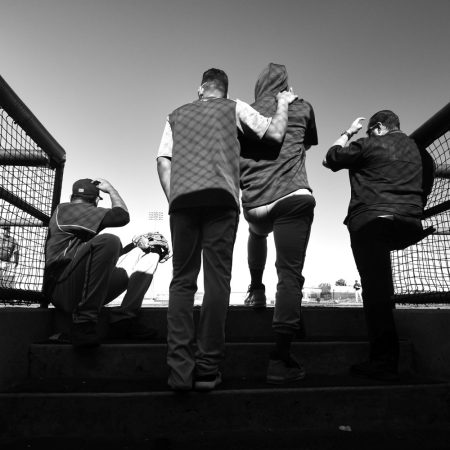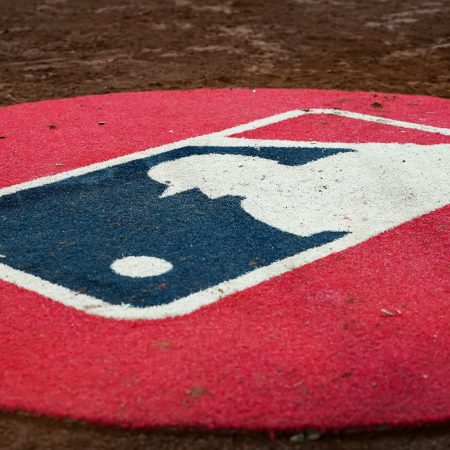It was still jacket weather on May 14 in Flushing, New York. The on-again, off-again rain rendered baseball game conditions impossible for more than an hour and made things unsavory as the evening wore on. When Mets pitcher Chris Bassitt couldn’t get on the same pitch-selection page with fill-in catcher Patrick Mazeika, helping swell the eventual time-of-game to an Odyssean three hours and 30 minutes, the home fans at Citi Field booed their own battery.
But the offense put up runs in three of the first five innings, giving the Mets a 4-0 lead over the alien American League Westerners known as the Seattle Mariners. (They even wore green.) And after opposing left fielder Jesse Winker knotted up the game with a three-run homer in the top of the seventh inning, Mazeika put himself back into Mets fans’ good graces by slamming an unlikely home run of his own in the bottom of the frame. Edwin Díaz, before gaining national attention for his powerful, trumpet-laden introduction hype song, closed the contest out with three K’s in the ninth, giving the Mets the win and placing them atop the National League East division by 5.5 games.
In spite of the lingering chill and mist, Mets beat reporter Anthony DiComo tweeted at 11:48 pm that the 37,140-strong Citi Field crowd was “electric.” I was there with centerfield-stand superfans The 7 Line Army — and it was.
This past Tuesday, it was jacket weather once again at Citi Field as the Mets welcomed division foe the Miami Marlins (who also wear a shade of green sometimes). On May 14 a Mets Magic Number to clinch the division was a specter so distant it hadn’t come close to materializing. But by September 27, with the Mets in front of the Atlanta Braves by a single game, their Magic Number had matured and then withered to a single digit of eight. Yet here’s what DiComo tweeted after Tuesday’s rainless, seven-degree-warmer game: “Announced (paid) attendance at Citi Field tonight is 29,067, and the actual crowd looks far less substantial than that.” He added that since Labor Day the Mets have drawn more than 30,000 fans for a home game just twice and one of those was on a bobblehead giveaway night.
The next day on WFAN, a local sports talk radio station, broadcaster Brandon Tierney called out the fans for their apparent lack of enthusiasm during a divisional pennant race. “The Mets deserve better than this. If there were 17,000 fans in the house, I would be surprised,” he said. “I want to know why fans aren’t flooding what’s a great stadium to support what is a great team.”
Then, at the start of the game on Wednesday night, a video of an even more paltry crowd at Citi Field circulated on social media. Though the stands filled in as the matchup with the Marlins continued, the Mets once again failed to attract more than 30,000 fans. Paid attendance was 28,228 for what wound up being one of the best Mets games of the year, with the home team winning in extra innings after roaring back from a 4-0 deficit. It was also a vital win in the run-up to a pivotal series against the Braves that’s scheduled to begin tonight in Atlanta.
Why the relatively scant turnout for meaningful September baseball?
Tierney’s broadcast partner, former New York Giants football star Tiki Barber, speculated that by the time September rolls around, Mets fans, unused to experiencing a quality product at Citi Field, have become conditioned to pay closer attention to local NFL teams. While baseball is winding down, the Jets and Giants are just kicking their seasons off, so perhaps there’s more excitement associated with fresh hopes in the nearby football cathedral of MetLife Stadium. (That theory helps explain the enthusiasm at a rain-soaked Citi Field back in May, just six weeks into the baseball season, against the non-rival Mariners.)
Some on social media echoed another Tierney observation that mid-week games in September are more challenging to attend for fans, particularly with children having returned to school after a summer break. (The May Mariners game was on a Saturday.)
However, the Twitterverse posed yet another possible reason for the small crowds at Citi Field, in yet another season where Major League Baseball attendance has dropped across the league, for cellar dwellers and playoff hopefuls alike. In response to one video of the stands from Wednesday night’s Mets game, @WamesJard tweeted, “We at work. Gotta pay for postseason tix.” Underneath, user @tdub1995 supported this take: “if [the] Mets weren’t making the playoffs, I’d be making 1 of the last home games. But right now I’m saving up for the playoffs. I’d much rather [see] a full house in the postseason.”
With three wild card teams in each league of the MLB playoffs for the first time, the Mets were guaranteed a seed with 13 games remaining, and eight days prior to the Marlins series, after a win in Milwaukee against the Brewers on September 19th. (The attendance for that Monday night game, in the home of another team chasing a playoff spot, was 25,671.) The expanded playoff bracket was designed to boost revenue, from television broadcast rights as well as ticket sales. But perhaps MLB gave itself a nose job to spite its face.
Ticket sales — and prices — will be higher at Citi Field and other stadiums around the league when the playoffs begin next week. However, this arguably comes at the cost of more robust gates during late-season games with teams gunning for division crowns. In the Mets’ case, winning the National League East would help their chances at a World Series championship exponentially. Should they falter and settle for a wild card position, they’d be forced to utilize their top two or three pitchers, including all-world studs Jacob deGrom and Max Scherzer, in a win-or-go-home three-game series. Even if they win that series, they will move on to face a more challenging opponent, unable to best leverage their exceptional starting staff, as deGrom, Scherzer and potentially Bassitt ride the bench to recover from their wild card-round starts.
That reality wasn’t enough to get a satisfying number of fans into the seats at Citi Field this past week, though. It seems many are content to wait and watch the Mets in the postseason, even if their positioning is far less favorable.
And this perceived problem at the gate is occurring in the lone division that has yet to be decided — though, with that said, it’s conceivable that the presence of additional wild card contenders could add to MLB’s overall attendance in the latter stages of the regular season. Still, on an individual team basis, the expanded playoff format, like in other professional team sports, seems to have had some detrimental impact on the importance of the regular season for fans. (When was the last time a basketball fan really cared about their favorite NBA team winning its division?)
At best it’s a give-and-take scenario, something MLB doesn’t appear concerned about. The league issued a statement to InsideHook that said: “The Mets are having a great season on the field and their fans have responded by creating an exciting environment at Citi Field. The Mets have drawn more than 2.5 million fans this season marking a nearly 10% increase over 2019, the most recent season where there weren’t pandemic-induced capacity restrictions for at least part of the season. We expect the Mets will draw strong crowds to Citi Field as they attempt to make a run at the World Series.”
After three crucial contests this weekend against the Braves, the Mets return home for the final three games of the regular season against the Washington Nationals. They’ll be played on a Monday night, a Tuesday night and a Wednesday afternoon. Unless the Mets somehow sweep the Braves — a team that’s been on a tear since June 1st — one of those games will determine the National League East winner.
I plan on being there. How many Mets fans join me remains to be seen. They probably won’t swarm the field as the Mets faithful did in ’86 when the team won the NL East. They might not even scream as hard as fans did in 1988 when the Mets won a second division title in three years. After all, the 2022 Mets have already made the playoffs.
This article was featured in the InsideHook newsletter. Sign up now.






















